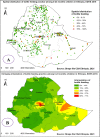Spatial distribution and determinants of bottle feeding among children 0-23 months in Ethiopia: spatial and multi-level analysis based on 2016 EDHS
- PMID: 35264134
- PMCID: PMC8905773
- DOI: 10.1186/s12887-022-03181-w
Spatial distribution and determinants of bottle feeding among children 0-23 months in Ethiopia: spatial and multi-level analysis based on 2016 EDHS
Abstract
Background: Bottle feeding is associated with diarrheal disease morbidity and mortality and risk of pyloric stenosis, especially in developing countries. Even though, World Health Organization (WHO) recommended avoiding bottle feeding among children, still higher magnitude was reported in developing countries. This study aimed to assess the spatial distribution and determinants of bottle feeding among children 0-23 months in Ethiopia.
Methods: This study was conducted based on Ethiopian Demographic and Health Surveys data (EDHS). The data were weighted using sampling weight for probability sampling and non-response to restore the representativeness of the data and get valid statistical estimates. Then a total of 4,275 weighted samples of under two years children were used to investigate the study. The data were cleaned using MS excel and extracted and analyzed using STATA V.16 software. A multilevel binary logistic regression model was fitted. P-value < 0.05 was taken to declare statistical significance. A spatial analysis was done using ArcGIS and SaTScan software.
Results: The prevalence of bottle feeding practice among under two years children in Ethiopia were 13.5% (95%CI: 11.16, 15.29) and ranges from the lowest 5.16% (95% CI: 3.28, 78.73) Amhara region to the highest 55.98% (95% CI: 47.98, 61.46) Addis Ababa region. Women with secondary and above education status [AOR=2.49; 95%CI; 1.66, 3.74], women from richest household [AOR=1.33; 95%CI; 1.01, 1.78], child 12-23 months age [AOR= 1.59; 95%CI; 1.23, 2.05], multiple birth [AOR=4.30; 95%CI; 1.88, 9.84], rural residence [AOR=0.49; 95%CI; 0.16, 0.82] and large central region [AOR= 0.15; 95%CI; 0.08, 0.27] have significantly associated with bottle feeding. Addis Ababa, Central Oromia, Dire Dewa, Somali and Harari regions were the hot spot areas for bottle feeding practice among under two years children.
Conclusion and recommendations: The prevalence of bottle feeding practices in Ethiopia is relatively moderate. Maternal education, wealth index, child age, multiple births, residence and region were significant predictors of bottle feeding. These findings highlight that, the Ministry of Health Ethiopia (MOH), policymakers, and other stakeholders had better give prior attention to preventable factors such as empowering women, enhancing household wealth status to decreasing bottle feeding practice in Ethiopia.
Keywords: Bottle feeding; Ethiopia; Spatial.
© 2022. The Author(s).
Conflict of interest statement
The authors declare that they have no competing interests.
There are no financial, non-financial, and commercial organizations competing of interests
Figures




References
-
- Gizaw G, Tesfaye G. Minimum Acceptable Diet and Factor Associated with It Among Infant and Young Children Age 6-23 Months in North Shoa, Oromia Region, Ethiopia. Int J Homeopathy Nat Med. 2019;5(1):1. doi: 10.11648/j.ijhnm.20190501.11. - DOI
-
- (WHO) W.H.o., Indicators for assessing infant and young child feeding practices, Washington D.C., USA. 2007.
MeSH terms
LinkOut - more resources
Full Text Sources

